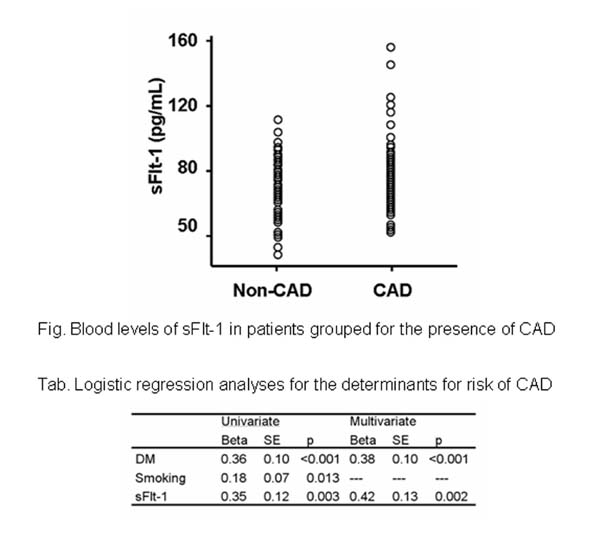| єя«•«ьљƒ : ±Єњђ
|
ЅҐЉцєш»£ - 520065 72 |
| Association between Blood Level of sFlt-1 (soluble VEGF Receptor 1) and Coronary Artery Disease in Hypertensive Patients |
| мЧ∞мДЄлМАнХЩкµР мЭШк≥ЉлМАнХЩ мЛђмЮ•лВік≥Љ, к±ік∞Хм¶ЭмІДкµРмЬ°нХЩк≥Љ¬є |
| мЭімГБнХЩ, к≥†мШБкµ≠, к∞ХмДЭлѓЉ, мµЬлПЩнЫИ, нХШмҐЕмЫР, мЮ•мЦСмИШ, м†ХлВ®мЛЭ, мЛђмЫРнЭ†, м°∞мКємЧ∞, мІАмД†нХШ¬є |
Background: sFlt-1 is known to be a soluble form of a receptor for vascular endothelial growth factor. However, its biological effects have not been completely understood. We performed this case-control study to evaluate the relationship between sFlt-1 and the risk of coronary artery disease (CAD) in hypertensive patients.
Methods: We enrolled 240 hypertensive patients (males: 190, females: 50, mean age: 60 yrs). CAD group was composed of 120 patients who had angiographically proven CAD, whereas control group was composed of age and sex-matched patients without history of CAD. Patients with acute coronary syndrome were excluded. At the time of enrollment, blood was sampled for measurement of sFlt-1. Logistic regression was used to evaluate the relationship between sFlt-1 and risk of CAD.
Results: Serum sFlt-1 level was significantly higher in patients with CAD than in patients without CAD (77 ± 20 pg/m vs 68 ± 17, p< 0.005)(Figure). The risk of CAD was associated with diabetes mellitus, smoking, sFlt-1. After adjustment for confounding variables, diabetes mellitus (p< 0.001), higher sFlt-1 (p=0.002) were identified as independent determinants of CAD (Table).
Conclusions: In patients with hypertension, higher sFlt-1 was significantly associated with the risk of CAD independent of other risk factors. Further study would be warranted to elucidate the clinical relevance of sFlt-1 elevation in CAD patients.
|
|
|
Warning: getimagesize(/home/virtual/circulationadmin/renewal/econgress/conference/abstract/img_files/flt1htcomb2-halfpixel.jpg) [function.getimagesize]: failed to open stream: No such file or directory in /home/virtual/circulationadmin/new/econgress/conference/manage/schedule/view_abstract.php on line 164

|
|





